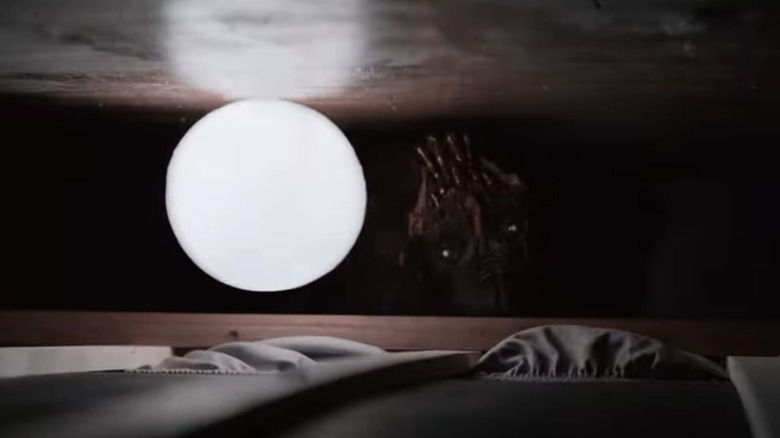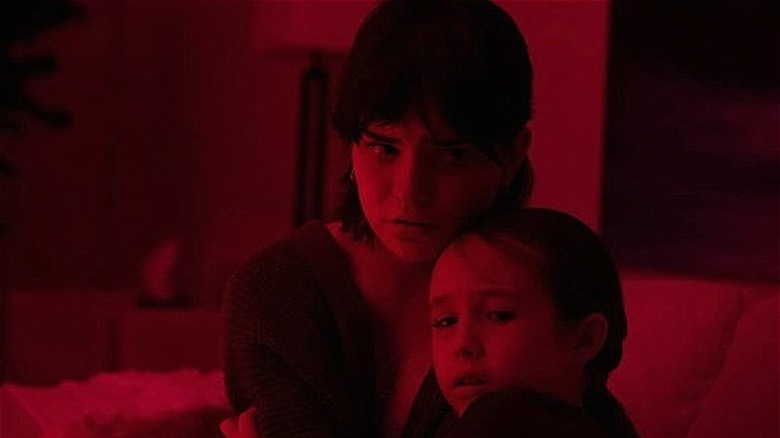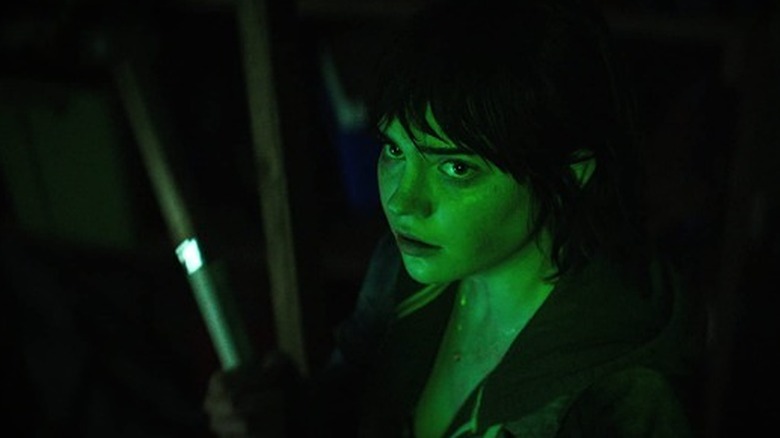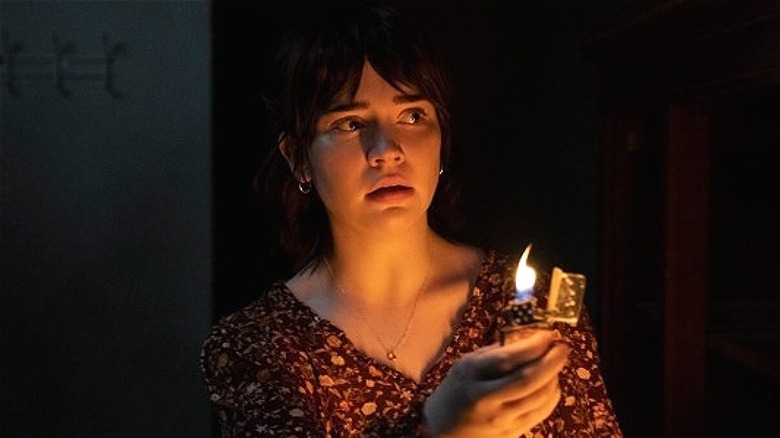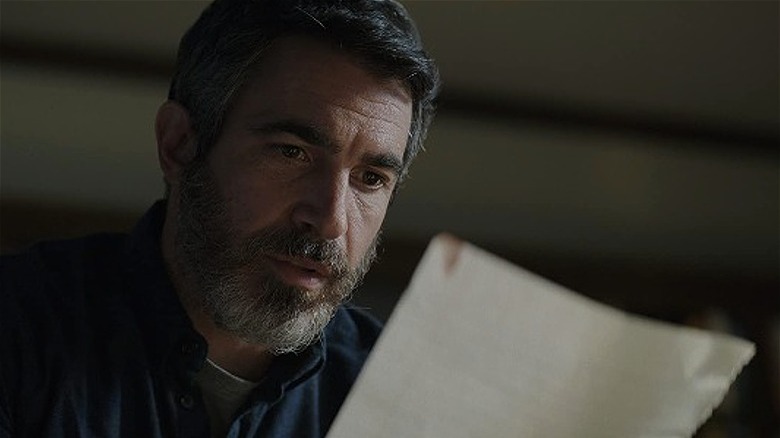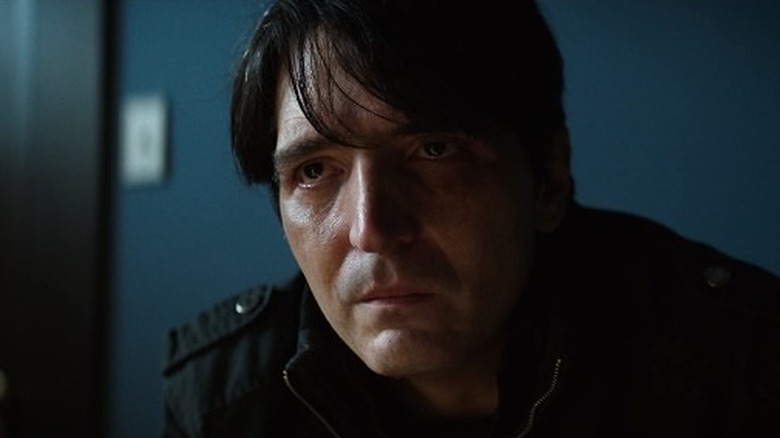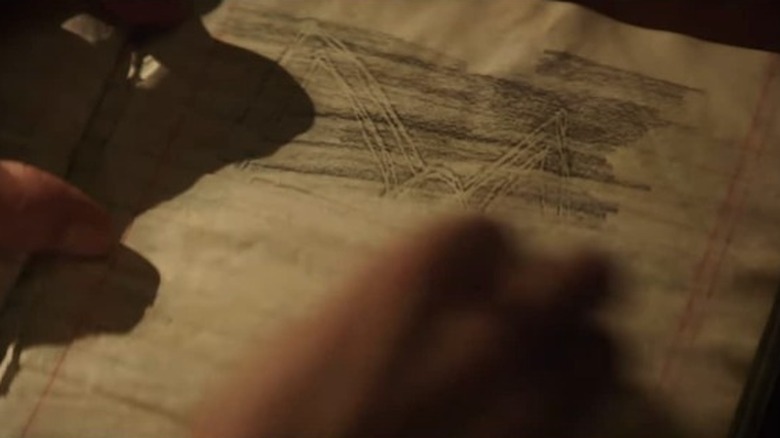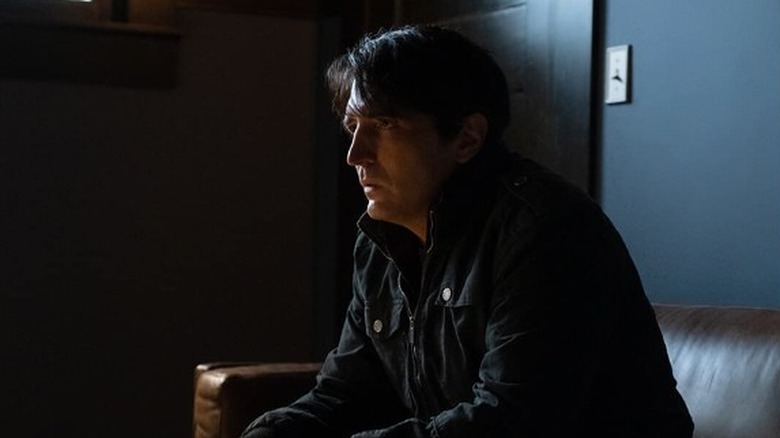The Ending Of The Boogeyman Explained
The following post contains spoilers for "The Boogeyman."
Most Stephen King adaptations contain more than their share of darkness. For decades, the Master of Horror has written about monsters dwelling in the darkest corners of humanity as well as the darkness we carry in the depths of our souls. In the new horror film "The Boogeyman," director Rob Savage brings to life one of the darkest stories in King's first short story collection. The sixth tale in "Night Shift" tackles both types of gloom with a soul-sucking ghoul that feeds on grief and a harrowing climax that takes place in near-total darkness.
The film's conclusion begins with Sadie Harper (Sophie Thatcher) rushing to warn her father about the sinister creature growing stronger in their home. When she arrives, she finds the lights extinguished and her little sister Sawyer (Vivien Lyra Blair) hiding in the closet. The frightened girls descend into their pitch-black basement armed with only a hockey stick and a string of Christmas lights to ward off the inky, black beast. They find their father in the monster's clutches and work together to save his life. After so much sadness and emotional distance, the three remaining Harpers finally find the strength to confront their pain and destroy the Boogeyman once and for all. With some help from beyond the grave, Sadie blasts the creature with fire and leaves it to die in their burning home.
Those terrifying sequences will likely leave many of us too scared to turn off our lamps come bedtime. With no sleep in sight, let's shine a light on this jaw-dropping finale to find out exactly what happened in the depths of the Boogeyman's lair.
What you need to remember about the plot of The Boogeyman
One month after the sudden death of her mother Cara (Shauna Rappold), Sadie returns to high school wearing an orange dress she associates with happy memories of her mom. You'd think that having a therapist for a father would make Sadie uniquely equipped to deal with her grief, but Will Harper (Chris Messina) has been avoiding emotional conversations with his daughters, leaving them to cope with the trauma on their own. Not only must Sadie work through her own feelings, but she's become a surrogate parent to her younger sister. The girls go to family therapy alone despite repeated requests for Will to come too.
Desperate for guidance, Sadie attempts to contact Cara in the spirit realm. After researching seances, she lights a candle and asks her mother to signal her presence by bending the flame to the left. Interrupted by Sawyer, Sadie misses the flame's subtle movement. Later, while going through her mother's possessions, Sadie finds a treasured Zippo lighter and asks her mother again to manipulate the flame. This time she hears a voice and sees a figure standing in the basement's shadowy corner. She can't see the face, but it's seemingly wearing an orange dress. Turning on the lights reveals a flash of her mother's face, but also the harsh reality that what Sadie thought was the ghost of her mother is actually a portrait of Cara in her signature frock.
What happened at the end of The Boogeyman
Sadie and Sawyer enter the basement with the odds firmly stacked against them. Not only has the Boogeyman – with hideous arms that extend from the depths of its jagged jaws — been around for ages, it can move seamlessly through the darkness and steal a person's will to keep fighting. The girls successfully save their father from the Boogeyman's clutches, but in the process, Will suffers a badly broken leg and the cord snaps on the green and red lights Sawyer has wrapped around herself for protection. The house's electricity goes out and the three Harpers are left in the darkness, knowing the Boogeyman could strike at any moment. The only weapons at their disposal? A bottle of lighter fluid and the Zippo Sadie found in her mother's things.
As the creature creeps closer, Sadie tries in vain to light a flame. After several attempts, the brief sparks she manages to make merely illuminate the room and reveal the monster moving in for the kill. Suddenly a huge flame bursts from the Zippo. The Boogeyman cowers as Sadie cries, "Mom," and the flame bends dramatically to the left. Using the lighter fluid, she blasts the thing with fire, hitting it over and over until the screaming creature collapses in flames. Unfortunately, this blaze spreads to the rest of the house and Sadie says goodbye to the treasured portrait of her mother as the house crumbles into a fiery wreck.
Sadie's mother has always been with her
Sadie narrowly misses the first signal from the ghost of her mother. The moment her flame bends slightly to the left, Sawyer knocks on her door, afraid there's something in her room. We know that what she's noticed is the Boogeyman beginning to toy with its food, but Sadie dismisses it as her sister's childhood fear. Rather than a coincidence, the Boogeyman has probably chosen this moment to terrorize Sawyer, knowing it would distract Sadie from her mother's signal. The beast plans to feed on her depression and knows that even the slightest reassurance might lift Sadie's spirits and spoil the sinister game.
Sadie has more success contacting her mother in the basement. She watches videos of Cara and unknowingly gives the Boogeyman fuel to create a cruel approximation. We see two visions of Sadie's mother, one in the dark and one in the light. The faceless woman standing by the portrait may be the Boogeyman impersonating Cara, similar to the way it wandered the Harper House disguised as Lester Billings (David Dastmalchian). When Sadie turns on the light, she sees her mother's true face for an instant, Cara's authentic spirit using light to contact her daughter. In the climactic basement battle, Cara's ghost once again uses fire to defend her family, producing a huge Zippo flame and sharply bending it to the left. Not only has Cara been with her family all along, her loving light is stronger than the Boogeyman's darkness.
The Harpers survive by overcoming their trauma
Savage's version of the Boogeyman is more than just a monster. This fearsome creature may be an inky black beast with sharp teeth and grasping arms, but it also serves as a metaphor for unresolved trauma. When Lester Billings books an impromptu therapy session in Will's home office, he confesses that he sought out his practice after learning about the death of his wife. No stranger to emotional pain, he knows that Will can offer advice from the depths of his own despair. Unfortunately, the Boogeyman knows this too. Having followed Billings into the Harper home and sensing fresh victims, the monster switches targets. The lurking force settles into the closet of Sawyer's room and terrorizes the child by creeping around the house at night. Will's emotional distance further fractures the beleaguered family, creating even more sorrow for the Boogeyman to savor.
Thankfully, Will and his daughters find their way back together. As the Boogeyman attacks Sadie, Will comes to her rescue despite his badly broken leg. After a month of ignoring his pain, the newly widowed father stares down a physical manifestation of trauma and finds the courage to fight back. Finally united, all three living members of the Harper family confront the darkness that's taken residence in their house. With help from Cara's spirit, they present an allied front and take the first scary steps toward recovery.
What Rob Savage says about the ending
Like much of King's early short fiction, "The Boogeyman" features a nihilistic tone and a shocking final stinger. Savage maintains the terror of the original text with several sequences in which the slinking predator follows Sadie and Sawyer around the house, always hiding just out of the light. Darkness becomes a character in its own right as the Boogeyman attempts to suck every bit of humanity out of the Harper home.
Though certainly frightening, Savage's film injects an uplifting dose of hope. A lifelong fan of the author, Savage notes that King balances his tales of bleak horror with narratives examining the power of human connection. In an interview with SFX Magazine, Savage describes the task of incorporating this aspect of King's writing into his own take on the ferocious story. "This movie attacks the source material in a way that's different from any other King adaptation," he says. "We wanted this to feel true to his writing. Me and [co-screenwriter] Mark [Heyman] were always going back to the warmth of character that you feel in King's novels. Even when the subject matter is dark, there's that glimmer of hope. He's not a cynical writer." King's overall optimism and humanity's ability to rise above evil can be felt throughout the film, marking a dramatic shift from the 50-year-old story.
What the end of The Boogeyman could mean for a franchise
The debut of a new Stephen King adaptation invariably sends Constant Readers and cinephiles alike scouring the screen for connections to other works in the author's massive catalog. For decades, King has loosely weaved together his own connected universe, using his "The Dark Tower" series as the lynchpin in a multi-dimensional world. Many fans would love to see more stories brought to life, perhaps additional tales from "Night Shift" or villains from his many novels.
No plans for a "Boogeyman" sequel have been announced yet, but the seeds of a franchise exist within Savage's film. The Boogeyman seeks out grieving people and finds the Harpers after terrorizing Lester Billings and his family. This opens the door for a prequel more in line with the original text. Possibly an ancient demon, this creature has survived for millennia and will likely find some way out of the smoldering remains of the Harper house. A new film could feature this devious monster feeding on the fear of another family. Savage concludes his film by implying that the Boogeyman has now settled in the closet of Dr. Weller (LisaGay Hamilton). What better place for a creature that consumes negative emotions to find fresh victims than the office of a family therapist? Sadie firmly closes this particular closet door and then walks into the sunshine with her family. If the Boogeyman returns in another installment, rest assured it will not be haunting the Harpers.
The alternate ending of The Boogeyman
When news first broke of a "Boogeyman" adaptation, many Constant Readers wondered how faithfully it would adhere to the original story. First published in 1973, King's text is a nasty piece of horror fiction with a sick stinger of an ending. The narrative takes place entirely within the confines of Dr. Harper's office and centers on Lester Billings as he tells tales of his children's deaths. Not only is Lester repugnant, spewing racist and misogynistic language as he unpacks his story, but an alternate reading suggests there's no Boogeyman and that Lester murdered his children in an uncontrollable rage.
Savage delivers a much more hopeful tone. Though not exactly a protagonist, his Lester is more pleasant, arriving at Dr. Harper's office obviously distraught about his kids. Savage teases the Boogeyman's survival with the aforementioned stinger, but King made his presence in the therapist's office explicit. His story ends with Lester agreeing to come back for additional sessions, but finding the receptionist's desk empty. As he wanders back into Dr. Harper's office, Lester watches Dr. Harper pull off his human mask and reveal himself to have been the Boogeyman all along. Viewed as a metaphor, this suggests Lester fears dealing with the crushing emotional weight of his children's deaths more than any monster. Savage's stunning sequence with the red flashing light informs us that confronting the darkness inside us will be challenging and even scary, but we are all capable of finding our way back into the light.
